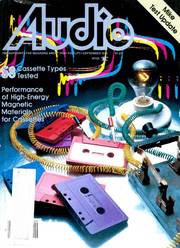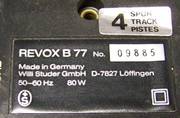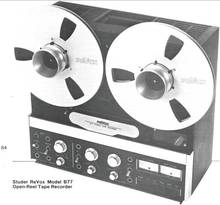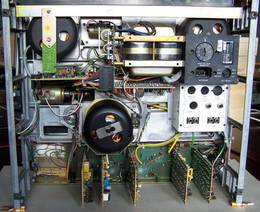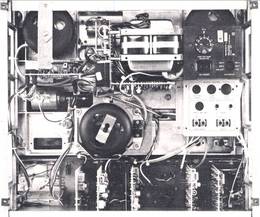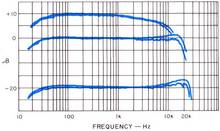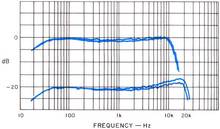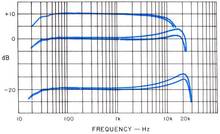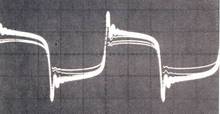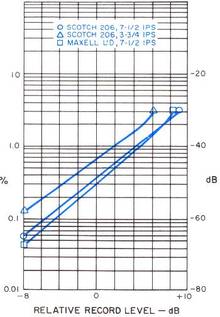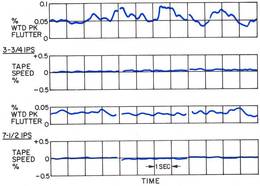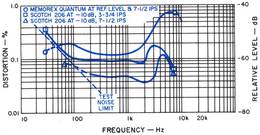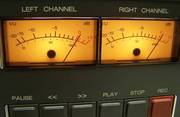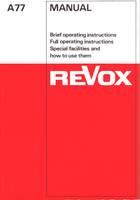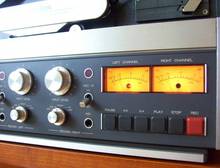Lobeshymnen in der US-AUDIO von 1978
Im Voraus ist es zum Verständnis der Wertigkeit dieses Artikels gut wissen, die Amerikaner bewerten und messen immer nach ihren eigenen Vorstellungen. Und die Amerikaner haben oft Verständnisprobleme mit Zusam- menhängen wie bei ReVox. ReVox Studer ist ja eigentlich eine echte Schweizer Firma, aber die ReVox Bandmaschinen haben fast überwiegend ein "Made in Germany" drauf. Das stiftet Verwirrung, da bei vielen Amerikanern die gesamte Schweiz sehr oft in Bayern vermutet wird. Wir lächeln darüber, die Amerikaner aber sind verwirrt.
Weiterhin wissenswert ist, daß die Vorgänger-Bandmaschine der B77, die ReVox A77 - fast genauso wie der legendäre DUAL 1009 Plattenspieler - den gesamten amerikanischen Semi-Profi-Markt aufgerollt hatte. Da drüben hatte es richtig gekracht, sowohl bei den Laufwerks-Herstellern wie auch bei den Bandgeräte-Herstellern.
Weiterhin war es für Amerikaner oft unverständlich, daß die Europäer, es waren ja fast nur die Deutschen und Philips (Norelco), ein Produkt 2 oder 3 Jahre in Folge nahezu unverändert gebaut hatten. Die allermeisten US-Automodelle - die großen Blechkisten - wurden alle halbe Jahre optisch aufgefrischt, aber technisch so gut wie nicht verändert.
Studer ReVox Model B77 - Open-Reel Tape Recorder
Ein 5-Seiten Artikel aus der US-Audio Sept. 1978 ab Seite 84 bis 88. - Alleine das war schon eine Besonderheit in einem ur-amerikanischen Magazin und dann auch noch Lob ohne Ende.
Nicht nur dieser Artikel war ziemlich flau und farblos komplett in schwarz-weiß gedruckt. Das tat aber dem sogenannten "Impact", dem Einschlag keine Abbruch. Insgesamt wurden weltweit von den A77/B77 Modellen über 470.000 Maschinen verkauft und davon kamen unseres Wissens nach weit über 90% aus Old Germany aus Löffingen.
.
Hier beginnt der amerikanische Text :
The Studer ReVox B77 open-reel recorder retains the advantages of the A77, eliminates limitations of the earlier models, and adds features of its own. (The A77 remains in the product line, at least for the time being.)
The frontpanel styling of this high-class audiophile recorder is similar to that of the professional A700 model.
Interlocked push-button switches select speed, 3 3/4 or 7 1/2 ips. Below are the large-handle toggle switches for power and monitor selection and paralleled jacks for headphones.
This can be a handy feature at times, providing a front-panel output in addition to one for a set of phones. The level at these jacks is controlled by a dual-section, slip-clutch pot, which does not affect the regular line outputs on the back panel.
Input und output
The output selector switch, however, does affect all outputs including metering, and can be set for stereo, reverse stereo, left channel to both outputs, right channel to both outputs, and mono which combines the two channels and feeds the mix to all jacks.
The choices provided with this switch facilitate a number of tasks without the need to change connections and use adapters. The smooth-acting input level pots have knobs of a good size, an improvement over those on the A77.
Alongside are the record presets with a large status light above each switch, illuminated when the recording process starts. The large toggle handles are convenient, but were judged to be subject to inadvertent switching.
The input selector switches have positions for both low- and high-impedance single ended microphones, Radio (DIN), AUX, and for feeding in the output of the other channel for sound-on-sound recording.
Mike inputs are standard phone jacks, and it might be noted that mike/line or other mixing is possible, if recording is done on just one channel.
Die Anzeige-Instrumente und die Bedientasten
The two level meters have even illumination and excellent legibility. The peak indicators are located in the meter faces which gives a continuous, no-effort display without diverting attention from the VU meters.
The light-touch tape motion switches are logic controlled, and any order of commands will be followed, including Pause in a wind mode.
Unfortunately, it does of latch in, and the button must be held for the duration of the pause. The logic also permits going into record from fast wind, as long as the record presets are in and Play is held until recording starts.
Behind a flip-down cover are the reel-size switch and the Cue/Edit slide switch, which puts the tape in contact with the heads from Stop.
It is released by moving the pinch-roller arm or by going into play. When in Cue/Edit/ fast-wind modes become momentary-contact controlled for any needed tape shuttling.
Tape threading is quite straight-line, and there is notably more clearance than on the A77. There is easy access for cleaning and demagnetization and, with removal of the snap-on head assembly cover, alignment adjustments become immediately available.
To the right is another aid to editing, a small splicing block with a built-in, shear-type cutter. The counter and its reset are above the head assembly. The reel turntable shafts have spring-loaded retainers which work directly on small reels and will hold on the adapters required for large-hub 10 1/2-inch reels.
Auf der Rückseite :
The line-in/line-out phono jacks and their level-set pots on the back are clustered together with sockets for DIN-type systems and for optional remote controls for tape motion and capstan speed.
The tape-motion control includes record and timer-start functions. The speed control, in conjunction with tape-speed selection, can provide speeds all the way from 2.5 to 11 ips.
Just above are the voltage selector, a fuseholder, and the socket for the detachable power cord. With the addition of another plug-in module (not in the unit evaluated), the B77 can have a slide-sync function. The carrying handle on the top of the high-impact polypropylene cabinet allows one-hand transporting for that live recording, very possible with the admirably low weight of 37.4 lbs.
Einblick in das Innenleben
After removal of the four retaining screws, the recorder assembly on its rigid, box-girder frame was pulled out for inspection.
There are 10 PCBs (printed circuit boards) with high-quality components, and all had excellent soldering. The overlay on the cover for the plug-ins was marked to show the location of adjustments behind the panel, but the parts on the cards themselves were not identified.
Plug-type connections were used for most purposes, with a minimum of interconnection soldering. Many items conveyed the impression of ruggedness for long-term reliability, but the turntable and capstan motors along with the brake and play solenoids were most notable.
The capstan frequency pick-off was rigidly mounted adjacent to the slots in the rotor shell, fundamental elements in the ReVox drive system which are basically immune to variations in line voltage or frequency.
Performance
The playback response of the B77 was within 2dB at both speeds with the exception of 50 Hz at 7 1/2 ips. The pink-noise/RTA checks showed that the record/playback responses were very good for Ampex 456, Maxell UD, Memorex Quantum, and TKD Audua, as well as with Scotch 206/207 for which the unit had been adjusted.
Meter indications for the reference levels on the test tapes were very close, with the zero indication within 0.5dB of the 257 nWb/m ReVox specification.
The reference record level used was that for 200 nWb/m fluxivity at 1.000 Hz, which was about -1.5 dB on the meters. (Note that flux levels at other frequencies are different even when the record/playback response is perfectly flat.)
The response with Scotch 206 at reference level and 7 1/2 ips (Fig. 1) was within 3dB from 17Hz to 18kHz for the left channel, to 20kHz for the right. The responses 20dB lower were from 16Hz to 23.5kHz (left) and 25.5kHz (right). With the record level +10dB, the -3dB points were at 21Hz and about 7kHz.
These results for Scotch 206 are not all that unusual at the high frequency end, but the smoothness over the entire frequency range is excellent indeed.
Weitere Lobeshymnen
Studer ReVox claims for superior head design are graphically illustrated with the extended low-frequency response with just the slightest indication of head contour effects, superb performance.
Similar plots were made using Memorex Quantum at 3 3/4 ips (Fig. 2). At reference level, response was from 20Hz to 13kHz. At the -20dB record level, the upper limit moved out to 23.5kHz (average), but there was a peak in the response around 17kHz.
With Maxell UD at 7 1/2 ips, the responses extended further than with Scotch 206, but at the expense of excessive peaking at the highest frequencies (Fig.3).
This deviation could be reduced greatly with a slight increase in bias. The small discrepancies between the two channels could be eliminated in similar fashion. Studer ReVox, however, takes the position that bias switches or pots should not be readily accessible because of possible abuse by unqualified users.
That is a valid point, but I suspect that the more technically oriented owners will drill access holes in the bottom of the cabinet, just as many have done with the A77s.
The playback of a recorded 10kHz tone had a 30 degree phase discrepancy between channels, evidence of very good alignment between the heads.
Phase jitter at 7 1/2 ips was 15 degrees, also very good. The bias residual in the output was down into tape noise, excellent design and adjustment.
The playback of a recorded 1 kHz square wave had relatively small tilt (Fig. 4), another demonstration of the superb low-frequency response, and some short-duration ringing at the EQ peaking-frequency. Some momentary, partial dropouts appeared in the stored waveform.
Der Klirrfaktor
(im Englischen = "HDL" = harmonic distortion)
Plots were made of HDL3 vs. record level for Scotch 206 at both speeds and Maxell UD at just 7 1/2 ips (Fig. 5). On a dB-dB basis, the functions were the most linear ever measured, with just a slight upturn near the 3% points.
At the low end, HDL3 continued to reduce to the noise limits of the test equipment, with little evidence of distortion in the electronics.
From 30Hz to 7kHz, HDL3 was very low, particularly at 10dB below reference level. Throughout this entire range, other harmonics were consistently very low, excellent magnetic design.
Signal-to-noise ratios with IEC "A" weighting at 7 1/2 ips were 58.7 dBA for Scotch 206 and 59.3 dBA for Memorex Quantum at reference level, and 67.0 and 70.0 dBA for the same tapes for HDL3 = 3%.
At 3 3/4 ips using the Memorex tape, the figures were 57.1 dBA at reference level and 65.2 dBA at the 3 per cent point.
Die Meßwerte : Überall nur "excellent "
These are all excellent figures, and don't forget - without Dolby NR. With CCIR weighting, the relative results were the same, but all of the figures were 8 to 9 1/2 dB less (smaller number).
Separation from one channel to the other was a good 51dB, and crosstalk to the adjacent track of opposite play diction was a good 69dB. The erasure of a 1kHz was excellent by any standard, down at least 90dB.
The input sensitivity for low-impedance mike was all the way down to 0.046 mV, and even with the high-impedance setting only 1.4mV was required.
The line sensitivity was much higher than that normally encountered, just 17mV for a zero indication. All of the measured sensitivities were 6dB or more better than the specifications.
Input overload was 48dB or more above the sensitivity figures listed. Output clipping at the line-out jacks was reached at a level equivalent to a +17 meter indication.
.
The input level pots tracked within a dB for the same pot positions. In accordance with ReVox specifications, the output levels were measured with the meters at +6.
The line outputs averaged 1.48V, just a little less than the spec. The headphone output was 5.5V open circuit, 2.75V with a matching 220ohm load. Although the manufacturer recommends headphones with impedances from 200 to 600 ohms, the circuit will deliver a very adequate 190mV to 8ohm loads. (Many so-called 8ohm headphones are actually 100 ohms or so.)
The line-output level-set pots were left at maximum for all tests, although they provide up to 26dB attenuation for system matching. The sections of the monitor pot tracked within 1/2 dB over most of its rotation.
The total spread in output levels for all positions of the output selector switch was 1/2 dB, indicative of carefully set internal adjustment pots. The dynamic response of the two meters was in accordance with VU standards, but the extended frequency response to over 200 kHz is subject to question.
The peak indicator threshold was very close to +6 VU with a CW input, and was still firing with a toneburst with duration reduced to 15mS. The meter scaling was very close with maximum errors of 0.2dB.
Die stabile Bandgeschwindigkeit bei 110 bis 130 Volt
All indications from test tapes and a strobe were that the recorder tape speeds were close to exact. There were no indications whatsoever of speed changes from 100 to 130 line voltage.
At 3 3/4 ips, the typical weighted peak flutter was 0.06%. At 7 1/2 ips, the flutter was 0.028% on the average, with a maximum value of 0.04% (Fig. 6).
- Anmerkung : Das sind Specs, über die wir uns hier bei uns nie Gedanken gemacht hatten, weil die Bandgeschwindigkeit über die 50Hz Netzfrequenz und dann über die Motorachse, die mechanischen Abmessungen der Reibräder oder Riemen-Umlenkrollen bestimmt wurde. In den USA schien das aber anders zu sein oder man traute den Europäern nicht über den Weg.
These results are well within the specifications and are direct evidence of superb tape motion. There were substantially no shifts in record-to-playback speed, and a slight shift plotted in one case was from drift in the metering.
The wind times for a 3600-foot 10 1/2" reel was 132 seconds. The time required to go from fast wind to play was less than two seconds at all times, smooth and fast.
Listening & Use Tests
Tape loading was easy and direct with little to snag the tape on, and there was good access for regular cleaning and demagnetization.
Snapping off the head assembly cover did improve access to the capstan and scrape flutter filter. There was a good feel to all of the pots and switches during all phases of the testing.
The logic-controlled, tape-motion switching performed without error, including the usual "torture" test. As stated before, a latch-in pause control did seem a definite lack at times. There was good meter action, and the placement of the overload LEDs seemed ideal in actual use.
.
There were some troubles with tape motion, but the major difficulties disappeared with use. When first started in play, there was a scraping noise from the right reel turntable. Removing the front panel aided in making the tentative conclusion that some brake lining glue was rubbing against the brake band.
.
In any event, the sound was gone by the time the testing was complete. A minor ailment, but annoying, was slippage in the counter. The errors were not great, but they kept creating confusion on where the exact start/stop points were.
Das 3-sprachige User-Manual
The 44-page trilingual instruction book is logical and thorough with good descriptions complemented by clear illustrations.
No schematic is included, but there is an excellent signal-flow block, and circuits are given of the remote control units, so you could even make your own.
.
Die Bedienung der B77
Clicks from pause and stop were 5dB out of tape noise; the record click itself was cover by tape noise. Different sources were recorded, and there was nothing to fault in the playback.
The B77 really shone (Die B77 glänzte wirklich ......) when it was used to record the revised Mass by Leonard Kastle. (The earlier version had been performed on national PBS TV on Christmas 1977).
The whole combination of this easy-to-carry high- performance unit with its excellent metering and of the inherent qualities in the music and its performance generated a tape which caused many a comment on its excellence.
The US $ 1,295.00 price tag will be more than tough for some, but in a number of the important areas of recorder performance, the B77 is superior to units costing a fair amount more. Studer ReVox may very well have another winner.
Howard A. Roberson in September 1978
MANUFACTURER'S SPECIFICATIONS
Die Specs standen in der Beschreibung (dem Artikel) ursprünglich ganz am Anfang.
Frequency Response:
30 Hz to 16 kHz @ 3 3/4 ips,
30 Hz to 20 kHz @ 7 1/2 ips.
Harmonic Distortion:
1 per cent @ 3 3/4 ips, and
0.6 percent® 7 1/2 ips.
S/N Ratio:
59 dBA @ 3 3/4 ips,
62 dBA @ 71/2 ips.
Crosstalk: -45 dB - Erasure: 75 dB.
Input Sensitivity: Mike, Lo Z, 0.15mV, Hi Z, 2.8mV, Line 40mV. Overload Margin: 40dB
Output Level: Line 1.55V; Headphone 5.6V (open circuit) for 200- to 600-ohm phones.
Flutter: 0.1% wtd. peak @ 3 3/4 ips, 0.08 percent wtd. peak @ 7 1/2 ips.
Speed Tolerance: 0.2%
Wind Times: 135 seconds for 3600 feet.
Dimensions: 17.8" (45.2cm)W x 16.3" (41.4cm)H x 8.14" (20.7cm)D.
Weight: 37.4 lbs. (17 kg).
Price: US $ 1,295.00.

